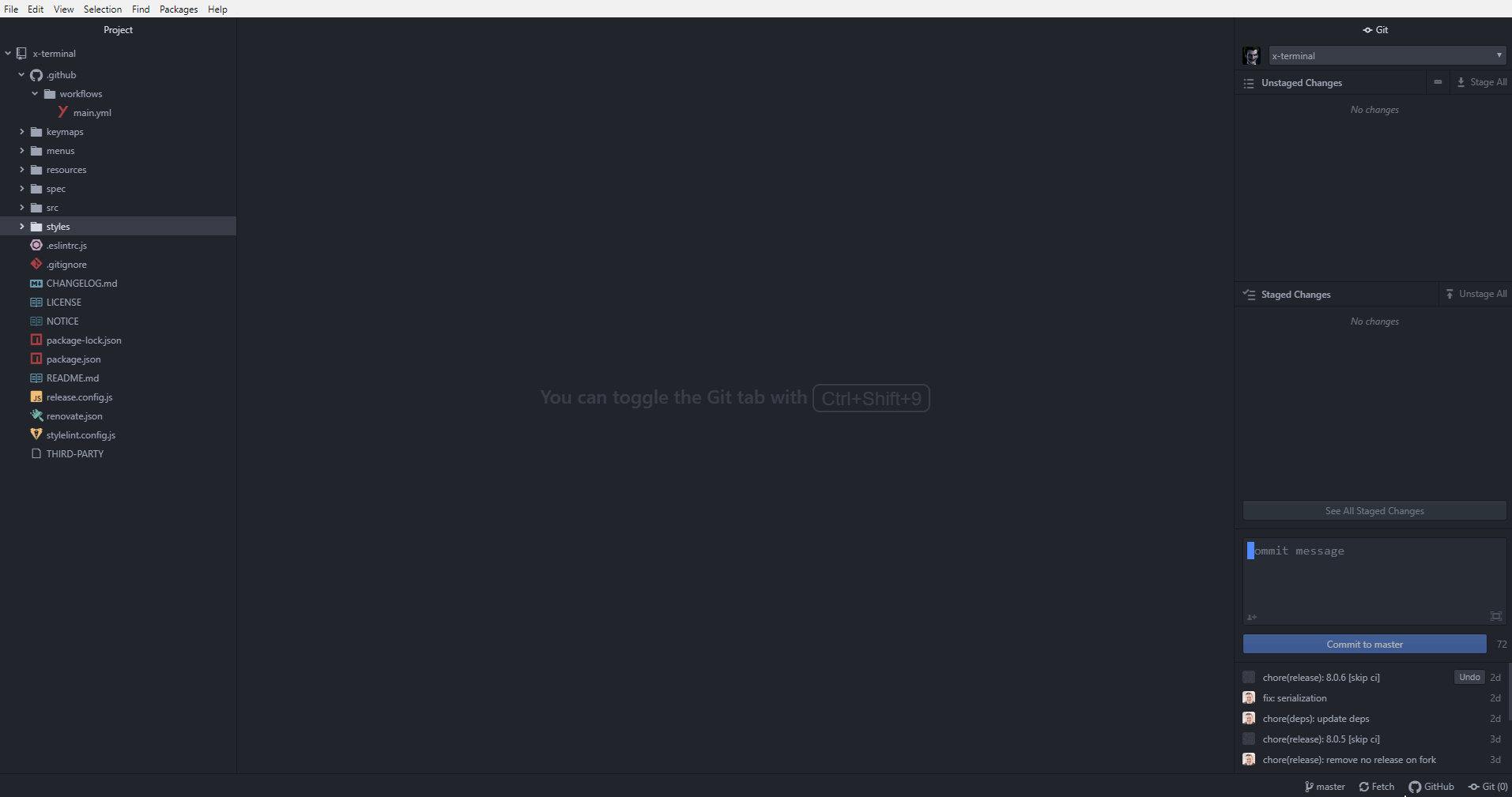This package provides the following services:
This package consumes the following services:
Terminal
Demo

Theme variables
The following theme variables are available to change the colors of the standard theme:
@app-background-color: #000000;
@text-color: #ffffff;
@background-color-selected: #4d4d4d;
@text-color-highlight: #ffffff;
@terminal-color-black: #2e3436;
@terminal-color-red: #cc0000;
@terminal-color-green: #4e9a06;
@terminal-color-yellow: #c4a000;
@terminal-color-blue: #3465a4;
@terminal-color-magenta: #75507b;
@terminal-color-cyan: #06989a;
@terminal-color-white: #d3d7cf;
@terminal-color-bright-black: #555753;
@terminal-color-bright-red: #ef2929;
@terminal-color-bright-green: #8ae234;
@terminal-color-bright-yellow: #fce94f;
@terminal-color-bright-blue: #729fcf;
@terminal-color-bright-magenta: #ad7fa8;
@terminal-color-bright-cyan: #34e2e2;
@terminal-color-bright-white: #eeeeec;
Active Terminal
The active terminal is the terminal that will be used when sending commands to the terminal.
The active terminal will always have an astrix (*) in front of the title.
By default when a terminal is hidden it becomes inactive and the last used
visible terminal will become active. If there are no visible terminals none are
active.
The Allow Hidden Terminal To Stay Active setting will change the
default behavior and keep a terminal that is hidden active until another
terminal is focused.
Services
For plugin writers, the terminal package supports two services, terminal and platformioIDETerminal, which
can be used to easily open terminals. These methods are provided using Atom's services
API.
To use a service, add a consumer method to consume the service, or rather a JavaScript object that provides methods to open terminals and run commands.
'terminal' service v1.0.0
The terminal service provides an object with updateProcessEnv, run, getTerminalViews, and open methods.
As an example on how to use the provided run() method, your
package.json should have the following.
{
"consumedServices": {
"terminal": {
"versions": {
"^1.1.0": "consumePlatformioIDETerminalService"
}
}
}
}
Your package's main module should then define a consumePlatformioIDETerminalService
method, for example.
import { Disposable } from "atom"
export default {
terminalService: null,
consumePlatformioIDETerminalService(terminalService) {
this.terminalService = terminalService
return new Disposable(() => {
this.terminalService = null
})
},
// . . .
}
Once the service is consumed, use the run() method that is provided
by the service, for example.
// Launch `somecommand --foo --bar --baz` in a terminal.
this.terminalService.run(["somecommand --foo --bar --baz"])
Development
Want to help develop terminal? Here's how to quickly get setup.
First use the apm command to clone the terminal repo.
apm develop terminal
This should clone the terminal package into the $HOME/github/terminal
directory. Go into this directory and install its dependencies.
cd $HOME/github/terminal
npm install
You shouldn't need to rebuild any node-pty since they are pre-compiled, however in the event they aren't available, you can rebuild them with:
apm rebuild
Finally, open this directory in Atom's dev mode and hack away.
atom --dev
There's a test suite available for automated testing of the terminal package.
Simply go to View > Developer > Run Package Specs in Atom's main menu or
use the hotkey. You can run the full test suite (which includes running lint
tools) via command-line by running npm run test inside the terminal
directory.
Various lint tools are being used to keep the code "beautified". To run only
the lint tools, simply run npm run lint.
Pull Requests
Whenever you're ready to submit a pull request, be sure to submit it
against a fork of the main terminal repo
master branch that you'll own. Fork the repo using Github and make note of the
new git URL. Set this new git URL as the URL for the origin remote in your
already cloned git repo is follows.
git remote set-url origin ${NEW_GIT_URL}
Ensure your new changes passes the test suite by running npm run test.
Afterwards, push your changes to your repo and then use Github to submit a new
pull request.
xterm.js
The terminals that users interact with in this package is made possible with major help from the xterm.js library. As such, often times it's necessary to make changes to xterm.js in order to fix some bug or implement new features.
If you want to work on xterm.js for the benefit of a bug fix or feature to be supported in terminal, here's how you can quickly get setup.
First make a fork of xterm.js. Next, clone your newly created fork as follows.
git clone ${YOUR_XTERMJS_FORK} ${HOME}/github/xterm.js
Go into your newly cloned repo for xterm.js.
cd ${HOME}/github/xterm.js
Install all needed dependencies.
npm install
Build xterm.js.
npm run build
Ensure the test suite passes.
npm run test
npm run lint
Add a global link for xterm.js to your system.
npm link
Inside your terminal directory, link against the global xterm link.
cd ${HOME}/github/terminal
npm link xterm
Finally, perform a rebuild with the apm program inside the terminal directory.
apm rebuild
You're all set for developing xterm.js. Hack away in your xterm.js directory,
run npm run build, then reload your Atom window to see the changes to your
terminals.
Credits and Legal
Click for copyright and license info about this package.
Feedback
Need to submit a bug report? Have a new feature you want to see implemented in terminal? Please feel free to submit them through the appropriate issue template.
For bug reports, please provide images or demos showing your issues if you can.
